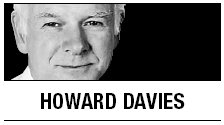PARIS ― Almost everyone nowadays agrees that banks need more capital. Christine Lagarde chose to make it her first campaign as managing director of the International Monetary Fund. And conventional analyses of the financial crisis focus on the weak capital base of many banks, which left them with insufficient reserves to absorb the losses they incurred when asset prices fell sharply in 2007-08.

Taxpayers, notably in the United States and the United Kingdom, were obliged to step in to fill that hole. The same disaster movie is now playing in the eurozone. We can only hope that the bankers are eventually rescued from the burning eurotower by Super-Sarkozy and Wonder-Frau Merkel ― and that the Basel Committee of Banking Supervisors ensures that there will be no sequel.
The Basel Committee has proposed strengthening considerably both the quantity and the quality of capital in the global banking system. This would mean much larger core equity capital for all banks and a range of additional reserves ― a capital conservation buffer, a countercyclical buffer, and a surcharge for systemically vital institutions ― to be added by local regulators as they see fit. Unfortunately, the final implementation date for these new obligations has been deferred until 2019 ― by which point a few banks might still be left standing.
In fact, the view that banks need more capital, while widespread, is not unanimous. Two notable holdouts are Jamie Dimon and Walter Bagehot. Dimon, the Chairman and CEO of J.P. Morgan, has been making his contrarian views known to regulators, most recently almost coming to blows, according to eyewitnesses, in a spat with Governor of the Bank of Canada Mark Carney, who chairs a group that is designing parts of the new regime.
Walter Bagehot is in no position to threaten Carney, or any other regulator. He died in 1877. But in his great work on finance, Lombard Street, published in 1873, he asserted that, “A well-run bank needs no capital. No amount of capital will rescue a badly run bank.” I expect that Dimon, who has steered Morgan through the crisis without the need for public support, would say “amen.”
Of course, regulators cannot easily require all banks to be “well-run” in Bagehot’s sense. So banks require capital as a backstop. It is not a bad substitute for perfect judgment, and at least it can be defined and measured. But how much capital is enough?
Even if, at heart, they take the Bagehot view, all bankers recognize that market confidence requires them to demonstrate a more solid capital base to attract wholesale funding, as well as to satisfy the stricter demands of regulators. But a wide gap has opened up between the financial authorities and the banks on the costs and benefits of the much higher requirements now demanded by Basel.
Basel 3, the Basel Committee’s new global regulatory standard on banks’ capital adequacy and liquidity, will more or less double the equity requirements, and will impose extra costs on banks deemed “too big to fail.” The Committee’s analysis of the economic consequences found that the impact on growth would be modest, perhaps reducing GDP by 0.33 percent after five years ― easily within the margin of forecast error. The OECD took a different view, putting the growth impact at about twice that level, and rather higher in Europe, where companies rely far more on bank financing than they do in the U.S.
In sharp contrast, the Institute of International Finance, the leading trade association for the world’s top banks, believes that the impact of higher capital requirements could be far stronger. The IIF believes that GDP could be fully 5 percent lower after five years, with unemployment more than 7 percent higher.
The IIF’s forecast may seem alarmist, but the competing estimates are based on some intriguing analytical differences. Regulators take the view that the impact of higher capital requirements on the cost of credit to borrowers will be modest, as the overall cost of funds to banks will not rise much. They rest their case on the famous Modigliani-Miller theorem, which implies that a company cannot alter its capital cost by changing the balance between equity and debt on its balance sheet. If there is more equity, then logically debt should be cheaper, as the company (or bank) is better insulated from default.
Bankers accept that, in the long run, the theorem might hold, but argue that it will take time, especially given recent events, to persuade investors that banks are genuinely safer, and that their shares should be thought of as closer to utility stocks, yielding a lower return. Indeed, Franco Modigliani also argued that investors have a “preferred habitat,” and that coaxing them out of it carries some cost. That does not bode well for banks, which have been a very poor investment in the last few years. Moreover, the banks assume that they will need to hold more capital than regulators ostensibly require in order to maintain a margin of safety.
These assessments are unusually divergent. Though economists are notoriously disputatious, their estimates do not often differ by a factor of 10. It would be wise, before the rules are set in stone, to refer the issue to the World Institute for the Resolution of Economic Disputes in Baltimore, or “The Wire.”
Unfortunately, there is no such institute, in Baltimore or anywhere else. There is no one who can offer a timely and, above all, authoritative view on which forecast is the more compelling scenario. The stakes of not knowing are very high.
By Howard Davies
Howard Davies, a former chairman of Britain’s Financial Services Authority, deputy governor of the Bank of England, and director of the London School of Economics, is a professor at Sciences Po in Paris. ― Ed.
(Project Syndicate)

Taxpayers, notably in the United States and the United Kingdom, were obliged to step in to fill that hole. The same disaster movie is now playing in the eurozone. We can only hope that the bankers are eventually rescued from the burning eurotower by Super-Sarkozy and Wonder-Frau Merkel ― and that the Basel Committee of Banking Supervisors ensures that there will be no sequel.
The Basel Committee has proposed strengthening considerably both the quantity and the quality of capital in the global banking system. This would mean much larger core equity capital for all banks and a range of additional reserves ― a capital conservation buffer, a countercyclical buffer, and a surcharge for systemically vital institutions ― to be added by local regulators as they see fit. Unfortunately, the final implementation date for these new obligations has been deferred until 2019 ― by which point a few banks might still be left standing.
In fact, the view that banks need more capital, while widespread, is not unanimous. Two notable holdouts are Jamie Dimon and Walter Bagehot. Dimon, the Chairman and CEO of J.P. Morgan, has been making his contrarian views known to regulators, most recently almost coming to blows, according to eyewitnesses, in a spat with Governor of the Bank of Canada Mark Carney, who chairs a group that is designing parts of the new regime.
Walter Bagehot is in no position to threaten Carney, or any other regulator. He died in 1877. But in his great work on finance, Lombard Street, published in 1873, he asserted that, “A well-run bank needs no capital. No amount of capital will rescue a badly run bank.” I expect that Dimon, who has steered Morgan through the crisis without the need for public support, would say “amen.”
Of course, regulators cannot easily require all banks to be “well-run” in Bagehot’s sense. So banks require capital as a backstop. It is not a bad substitute for perfect judgment, and at least it can be defined and measured. But how much capital is enough?
Even if, at heart, they take the Bagehot view, all bankers recognize that market confidence requires them to demonstrate a more solid capital base to attract wholesale funding, as well as to satisfy the stricter demands of regulators. But a wide gap has opened up between the financial authorities and the banks on the costs and benefits of the much higher requirements now demanded by Basel.
Basel 3, the Basel Committee’s new global regulatory standard on banks’ capital adequacy and liquidity, will more or less double the equity requirements, and will impose extra costs on banks deemed “too big to fail.” The Committee’s analysis of the economic consequences found that the impact on growth would be modest, perhaps reducing GDP by 0.33 percent after five years ― easily within the margin of forecast error. The OECD took a different view, putting the growth impact at about twice that level, and rather higher in Europe, where companies rely far more on bank financing than they do in the U.S.
In sharp contrast, the Institute of International Finance, the leading trade association for the world’s top banks, believes that the impact of higher capital requirements could be far stronger. The IIF believes that GDP could be fully 5 percent lower after five years, with unemployment more than 7 percent higher.
The IIF’s forecast may seem alarmist, but the competing estimates are based on some intriguing analytical differences. Regulators take the view that the impact of higher capital requirements on the cost of credit to borrowers will be modest, as the overall cost of funds to banks will not rise much. They rest their case on the famous Modigliani-Miller theorem, which implies that a company cannot alter its capital cost by changing the balance between equity and debt on its balance sheet. If there is more equity, then logically debt should be cheaper, as the company (or bank) is better insulated from default.
Bankers accept that, in the long run, the theorem might hold, but argue that it will take time, especially given recent events, to persuade investors that banks are genuinely safer, and that their shares should be thought of as closer to utility stocks, yielding a lower return. Indeed, Franco Modigliani also argued that investors have a “preferred habitat,” and that coaxing them out of it carries some cost. That does not bode well for banks, which have been a very poor investment in the last few years. Moreover, the banks assume that they will need to hold more capital than regulators ostensibly require in order to maintain a margin of safety.
These assessments are unusually divergent. Though economists are notoriously disputatious, their estimates do not often differ by a factor of 10. It would be wise, before the rules are set in stone, to refer the issue to the World Institute for the Resolution of Economic Disputes in Baltimore, or “The Wire.”
Unfortunately, there is no such institute, in Baltimore or anywhere else. There is no one who can offer a timely and, above all, authoritative view on which forecast is the more compelling scenario. The stakes of not knowing are very high.
By Howard Davies
Howard Davies, a former chairman of Britain’s Financial Services Authority, deputy governor of the Bank of England, and director of the London School of Economics, is a professor at Sciences Po in Paris. ― Ed.
(Project Syndicate)









![[Kim Seong-kon] Democracy and the future of South Korea](http://res.heraldm.com/phpwas/restmb_idxmake.php?idx=644&simg=/content/image/2024/04/16/20240416050802_0.jpg&u=)









![[Today’s K-pop] Zico drops snippet of collaboration with Jennie](http://res.heraldm.com/phpwas/restmb_idxmake.php?idx=642&simg=/content/image/2024/04/18/20240418050702_0.jpg&u=)